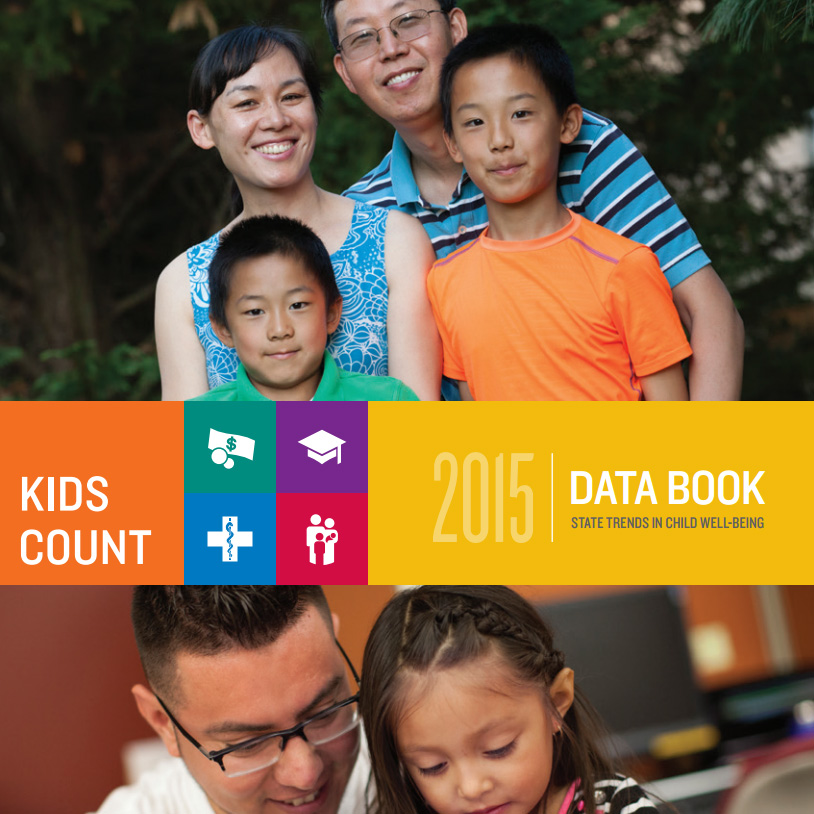One in four children lived in a low-income working family in 2013, and nearly one in three lived in a house where neither parent has full-time employment, suggesting that recovery from the Great Recession is leaving millions of children behind.
That’s one of the messages from the 2015 Kids Count Data Book report, released today. The report, funded and supported by the Annie E. Casey Foundation, looks at four broad measures of child well-being for the years 2008-2013. Those measures include education, health, family and community, and economic well-being.
The report found that while well-being improved on some measures, about 1.7 million more children live in low-income working families than during the Great Recession. In addition, while the economic recovery after the Recession led to increased wealth for some individuals, millions of children were left behind. For example, the report shows the number of children living in high-poverty neighborhoods is higher than at any time since 1990. Also, 2 million more kids live in areas of concentrated poverty than did during the years 2006 through 2010.
[Related: Why Do Low-Income Kids Suffer So Much Summer Learning Loss?]
While hailing good news from the report — teen pregnancies continue to decline, more children have insurance than in previous years — a Casey policy expert said that the economic declines “are deeply troubling.” The growing number of children living in high-poverty neighborhoods, defined as having 30 percent or more households in a census tract living in poverty, is of particular concern, said Laura Speer, associate director for policy reform and advocacy.

AECF
Laura Speer, associate director for policy reform and advocacy at the Annie E. Casey Foundation
“We know that living in those neighborhoods can negatively impact children,” said Speer. “This trend is going in the wrong direction.”
Typically, high-poverty neighborhoods have poor access to health care, lower-quality schools and safe places to play, Speer noted.
“Among the most disturbing things is that, if you look at 2008, right smack in the middle of the Recession, the numbers are better than they were in 2013,” Speer said.
Children of color were more likely to be mired in poverty than their white peers, the study concluded. For example, African-American children were more than twice as likely to live in neighborhoods of high poverty and also to live in single-parent homes.
Native-American children were more than twice as likely to have no health insurance.
And, Latino children are most likely to live in a household headed by someone without a high school diploma.
The housing crash is partly behind the increase, Speer said, with tens of thousands of families driven from home by foreclosure. At the same time, rents rose in many neighborhoods as rental demand soared. That forced many families into lower-rent neighborhoods, Speer said.
Fixes to the inequality will not be easy, she said. “I wish I had the magic answer.”
The report also shows many improvements in education and health. Good news includes the fact that about 81 percent of high school students graduated on time and also that more children had access to health care in 2013 than before the Recession. Also, the number of children without health insurance declined to 7 percent in 2013 from 10 percent in 2008.
Fewer teens were shown to be abusing drugs in 2012-13, down to 6 percent from 8 percent in 2007-08.
The Annie E. Casey Foundation provides funding and technical support for Kids Count to collect and report data related to the welfare of children. A fact sheet for this year’s report is available online. For 26 years, Kids Count has issued yearly reports that inform policymakers, advocates, educators and others involved in designing programs to help children grow up healthy, strong, educated and safe.
More stories on related topics:
Low-income Kids Need to Be Taught How to Negotiate Life
After-School Programs for Low-Income Children Endangered by Proposed Senate Bill
Newark Program Prepares Low-Income Teens for College, Workforce


























